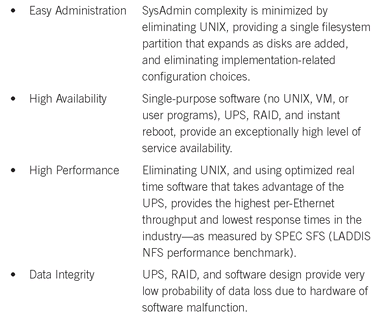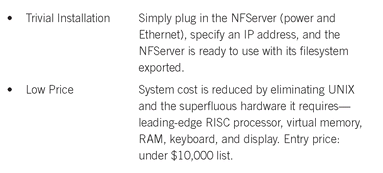1-800-SERVERS Business Plan Overview January 16, 1992
This confidential working document outlines the business plan for a proposed new company.
Mission
Develop, manufacture, distribute and support a family of file servers. Establish and maintain the market position of best price/performance.
Background
The rapid evolution and deployment of distributed computing technology has created enormous demands on the performance, capacity, and reliability of data storage servers. By the end of this decade, hundreds of millions of personal computers and workstations will require millions of servers. The servers, as well as the personal computers and workstations, will become commodity products.
Servers will primarily fall into two categories: file servers and database servers. Database servers will become increasingly important as client-server computing is used for more business applications. However, file servers will continue to be the most common repository of data in distributed computing networks.
Most personal computers use proprietary file server protocols, the most common of which is Novell’s NetWare. Almost all workstations use the open file server protocol, NFS. Today there are approximately 2.2 million workstations and personal computers that use NFS. The NFS market is much smaller than the NetWare market; it is also more open and less competitive.
More than a third of a million new workstations were shipped in 1990. Roughly one NFS file server is required for every seven workstations. Thus, approximately 50,000 NFS file servers were sold in 1990, representing over one billion dollars in sales. At current growth rates, sales should exceed $2 billion this year.
In the past four years, a small number of startups have produced NFS file servers. The most successful of these are Auspex and Epoch.
Auspex produces NFS servers with very high throughput performance. An Auspex server can handle up to eight heavily loaded Ethernets. Epoch’s product has much lower performance, but it provides an additional layer in the memory hierarchy: optical disk. The Epoch NFS file server is aimed at users who require huge amounts of storage. Both Auspex and Epoch are pursuing relatively narrow niches in the NFS market.
The Vision
There is an excellent opportunity to create a new company to provide commodity-like file servers that can be purchased at the departmental level, installed as easily as household appliances, and managed by users with no training or experience.
The company would initially develop an NFS file server that is differentiated by the following four features:
1. High Availability: It will run for longer periods of time between outages. Restart times will be very short. A fault-tolerant disk array and uninterruptible power supply will provide high data integrity.
2. Easy Administration: Installation will be trivial with no configuration decisions to make or parameters to set. All implementation details will be hidden. Little documentation and no training will be required.
3. High Performance: Lowest latency and full bandwidth utilization with one or two Ethernets.
4. Low Price: Under $10,000 entry price. Price/performance will be from five to ten times better than today’s NFS servers.
The key idea is to design the product from the ground up to be a file server and nothing but a file server. While the product will use open protocols, it will not be programmable by customers or by independent software vendors. It will not run any application programs.
The product will not run UNIX. Avoiding the complexities of UNIX will enable the product to achieve high performance and easy system management. (All existing NFS file servers are based on UNIX, or something slower and more complicated to manage—such as MVS. Auspex products are unique in that the NFS network requests do not go through the UNIX processor; this appears to be a major contributor to their high performance.)
The distribution strategy will exploit the product’s ease of installation. In North America, a strategy similar to the “Dell Model” will be used to make it as easy for customers to order and install an NFS file server as it is to order an external disk drive from La Cie and install it on a Macintosh.
Follow-on products could include a lower entry price model, a higher-performance model using a copper FDDI interface, and automatic file backup capabilities.
The software and hardware would be designed to facilitate the future development of non-NFS file servers. For example, a NetWare file server could be developed using the same philosophy, the same hardware, and most of the same software. Eventually it may also be possible to apply a similar approach to database servers, through a strategic alliance with a major database vendor.
The Proposed LADDIS Benchmark
Until recently, there was no consistent way to measure or compare the performance of NFS servers. The LADDIS Group has proposed an NFS server benchmark that will enable users to easily compare the performance of NFS servers. The LADDIS benchmark will encourage customers to view NFS servers as commodity products, and help to undermine their current brand loyalties.
The acronym LADDIS was derived from the names of the participating NFS vendors: Legato, Auspex, Data General, DEC, Interphase and Sun. The LADDIS Group submitted the proposed benchmark to SPEC (Systems Performance Evaluation Cooperative) in August 1991. As with other proposed SPEC benchmarks, the LADDIS benchmark must be scrutinized by all SPEC member companies before adoption.
The LADDIS benchmark generates a synthetic load of client requests that comprises a realistic mix of operations—read, write, lookup, etc.—and measures the response times of the server. The result is a graph of average response time (in milliseconds) as a function of throughput (in NFS operations per second).
Evaluation copies of PRE_LADDIS Version 0.0.11 will be available in February 1992. The official benchmark should be released by SPEC in late 1992. It is written in C and runs on most UNIX workstations.
The proposed LADDIS benchmark is already receiving attention in the UNIX trade press. Published LADDIS results will be a key tool for selling our proposed NFS server products.
The Product Plan
The software will be based on a real-time kernel. Some components will be derived from public domain software, such as the file system, the TCP/UDP/IP stack, and NFS. Proprietary components and modifications will be developed to achieve extremely simple system administration, high reliability, fast system restart, low response times for NFS operations, and high throughput performance.
The first product will use commodity board components based on EISA bus, an Intel 386 or 486 processor, an uninterruptible power supply, an array of disk drives (either 3.5-inch or 2.5-inch), an optical tape drive for backup, and one or two Ethernet interfaces. Storage capacity will be expandable from one to 20 gigabytes. It will be possible to insert new disk drives without disrupting client workstations. The goal will be to ship products within the first year to 18 months of operation.
The second product will integrate the network and disk interfaces onto the processor board, using a novel architecture to reduce manufacturing costs and to provide significant performance improvements.
Product development strategy will be guided by the following (somewhat inconsistent goals):
• Focus on developing unique added value.
• Focus on software; minimize hardware development and in-house manufacturing. Use partners to obtain hardware without losing the flexibility to change partners or do our own hardware in the future.
• Minimize royalty payments to third parties.
Competition
Sun Microsystems is the main supplier of NFS file servers. Sun sells over ⅔ of all NFS file servers. Our initial product will be positioned to cost significantly less than Sun’s lower-end server, with performance comparable to their high-end servers.
It is unlikely that Sun will be able to produce a server that performs as well, or costs as little, for several reasons:
• Sun’s server hardware is inherently more expensive because it has lower production volumes than our components, and it must be capable of supporting Solaris (UNIX System V Release 4)—which requires GUI hardware, a CD player, and one or more powerful RISC processors to achieve performance.
• Sun is unlikely to produce a file server that does not use UNIX.
• Sun’s move to UNIX System V Release 4 will probably introduce significant new performance problems that will take years to correct.
• The culture among software engineers at Sun places little value on performance.
• The structure of Sun—with SunSoft doing NFS and UNIX, and SMCC doing hardware—makes it difficult for Sun to produce products that provide creative software-hardware system solutions.
• Sun’s distribution costs will likely remain high due to the level of technical support required to install and manage a Sun server.
• Sun is focused on desktop workstations because desktop products have higher volumes than servers.
Sun will still be a formidable competitor through their installed base, channel control and FUD. Sun could react to losing sales by launching a performance improvement project and providing deep discounts. Hopefully, by being too far behind the power curve, Sun would eventually concede the file server market and focus on workstations. (Our product could help increase the size of Sun’s workstation market by decreasing the customer’s total capital investment and cost of ownership.)
No other workstation vendor appears to have an NFS server strategy that is more viable than that of Sun. Many workstation vendors do not provide file servers at all.
Auspex will not be able to compete at the low end of the NFS server market with their current architecture. Their product requires multiple processors, a VME bus, and UNIX. The Auspex architecture is inherently harder to manage and more expensive than that of the proposed product. We also expected our product to have significantly faster response times (lower latency) than can be achieved using the Auspex architecture.
Distribution
The goal would be to achieve a high market share as quickly as possible so that competitors have little time to react.
In North America, a small highly-focused direct sales force will call on large and strategic accounts. Eventually, most orders will be taken by phone using an 800 number. All servers will be sold with a 30-day return policy, and a full 1-year guarantee.
In countries where the use of an 800 number is not practical, appropriate resellers will be used. Low product support requirements will aid in obtaining resellers, in part because Sun Microsystems has already tied up most of the VARs and resellers that are capable of supporting UNIX products.
Goals of the Seed Stage
The Seed Stage of the company is expected to require six to nine months. The goals for this stage are:
• Hire the core technical team (5 or 6 people), plus a controller/office manager.
• Develop the software architecture.
• Write the product requirements document of the NFS server product.
• Acquire a software development and LADDIS testing system.
• Develop enough of the software to demonstrate a prototype NFS server running on commodity Intel-based hardware.
• Determine the feasibility of using such commodity hardware for the first product. Determine if performance goals can be met.
• Obtain one or two senior marketing and sales team members.
• Obtain reliable feedback from potential customers to ensure that the first product is designed and positioned properly. Identify beta testers.
• Tentatively qualify hardware components and vendors.
• Identify hardware partner(s).
• Complete the business plan.
• Obtain Development Stage financing.
NFServer: Preliminary Specifications
A New Kind of File Server
The NFServer is designed from the ground up to be a dedicated NFS fileserver. Using an imbedded real-time system, instead of UNIX, it provides easy administration, high availability, excellent data integrity, and high performance.
Major Components
• Uninterruptible Power Supply (UPS)
• Fault-tolerant disk array (RAID) with 1 GB to 16 GB capacity
• Fsck-less filesystem for instant boot
• Single expandable filesystem partition; grows as disks are added
• Custom real-time kernel optimized for NFS
• Full-screen administration tool
• SNMP agent
• Optional second Ethernet interface
• Optional tape drive for backup
Major Benefits 


